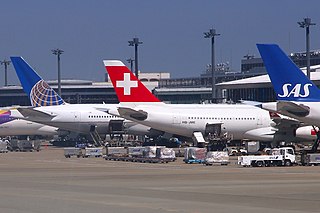Related Research Articles

Distribution is the process of making a product or service available for the consumer or business user who needs it, and a distributor is a business involved in the distribution stage of the value chain. Distribution can be done directly by the producer or service provider or by using indirect channels with distributors or intermediaries. Distribution is one of the four elements of the marketing mix: the other three elements being product, pricing, and promotion.
Brand equity, in marketing, is the worth of a brand in and of itself – i.e., the social value of a well-known brand name. The owner of a well-known brand name can generate more revenue simply from brand recognition, as consumers perceive the products of well-known brands as better than those of lesser-known brands.
Market penetration refers to the successful selling of a good or service in a specific market. It involves using tactics that increase the growth of an existing product in an existing market. It is measured by the amount of sales volume of an existing good or service compared to the total target market for that product or service. Market penetration is the key for a business growth strategy stemming from the Ansoff Matrix (Richardson, M., & Evans, C.. H. Igor Ansoff first devised and published the Ansoff Matrix in the Harvard Business Review in 1957, within an article titled "Strategies for Diversification". The grid/matrix is utilized across businesses to help evaluate and determine the next stages the company must take in order to grow and the risks associated with the chosen strategy. With numerous options available, this matrix helps narrow down the best fit for an organization.
In business, operating margin—also known as operating income margin, operating profit margin, EBIT margin and return on sales (ROS)—is the ratio of operating income to net sales, usually expressed in percent.

Gross margin, or gross profit margin, is the difference between revenue and cost of goods sold (COGS), divided by revenue. Gross margin is expressed as a percentage. Generally, it is calculated as the selling price of an item, less the cost of goods sold, then divided by the same selling price. "Gross margin" is often used interchangeably with "gross profit", however, the terms are different: "gross profit" is technically an absolute monetary amount, and "gross margin" is technically a percentage or ratio.
Cost per mille (CPM), also called cost per thousand (CPT), is a commonly-used measurement in advertising. It is the cost an advertiser pays for one thousand views or impressions of an advertisement. Radio, television, newspaper, magazine, out-of-home advertising, and online advertising can be purchased on the basis of exposing the ad to one thousand viewers or listeners. It is used in marketing as a benchmarking metric to calculate the relative cost of an advertising campaign or an ad message in a given medium.

Market share is the percentage of the total revenue or sales in a market that a company's business makes up. For example, if there are 50,000 units sold per year in a given industry, a company whose sales were 5,000 of those units would have a 10 percent share in that market.
The brand development index or BDI quantifies how well a brand performs in a market, compared with its average performance among all markets. That is, it measures the relative sales strength of a brand within a specific market.
The category development index (CDI) measures the sales performance of a category of goods or services in a specific group, compared with its average performance among all consumers. By definition, CDI measures the sales strength of a particular product category within a specific market.
All-commodity volume or ACV represents the total annual sales volume of retailers that can be aggregated from individual store-level up to larger geographical sets. This measure is a ratio, and so is typically measured as a percentage.
A product's average price is the result of dividing the product's total sales revenue by the total units sold. When one product is sold in variants, such as bottle sizes, managers must define "comparable" units. Average prices can be calculated by weighting different unit selling prices by the percentage of unit sales (mix) for each product variant. If we use a standard, rather than an actual mix of sizes and product varieties, the result is price per statistical unit. Statistical units are also called equivalent units.
Brand awareness is the extent to which customers are able to recall or recognize a brand under different conditions. Brand awareness is one of two dimensions from brand knowledge, an associative network memory model. It is a key consideration in consumer behavior, advertising management, and brand management. The consumer's ability to recognize or recall a brand is central to purchasing decision-making because purchasing cannot proceed unless a consumer is first aware of a product category and a brand within that category. Awareness does not necessarily mean that the consumer must be able to recall a specific brand name, but they must be able to recall enough distinguishing features for purchasing to proceed. Creating brand awareness is the main step in advertising a new product or bringing back the older brand in light.
Sales effectiveness refers to the ability of a company's sales professionals to “win” at each stage of the customer's buying process, and ultimately earn the business on the right terms and in the right timeframe. Improving sales effectiveness is not just a sales function issue; it's a company issue, as it requires collaboration between sales and marketing to understand what is working and not working, and continuous improvement of the knowledge, messages, skills, and strategies that sales people apply as they work sales opportunities.
In Marketing, Product category volume (PCV) is the weighted measure of distribution based on store sales within the product category. PCV is a refinement of all commodity volume (ACV). It examines the share of the relevant product category sold by stores in which a given product has gained distribution.
Price premium, or relative price, is the percentage by which a product's selling price exceeds a benchmark price. Marketers need to monitor price premiums as early indicators of competitive pricing strategies. Changes in price premiums can also be signs of product shortages, excess inventories, or other changes in the relationships between supply and demand. In a survey of nearly 200 senior marketing managers, 54 percent responded that they found the "price premium" metric very useful.
Willingness to recommend is a metric related to customer satisfaction. When a customer is satisfied with a product, he or she might recommend it to friends, relatives and colleagues. This willingness to recommend can be a powerful marketing advantage. In a survey of nearly 200 senior marketing managers, 57 percent responded that they found the "willingness to recommend" metric very useful.
Volume projections enable marketers to forecast sales by sampling customer intentions through surveys and market studies. By estimating how many customers will try a new product, and how often they’ll make repeat purchases, marketers can establish the basis for such projections.. .. Projections from customer surveys are especially useful in the early stages of product development and in setting the timing for product launch. Through such projections, customer response can be estimated without the expense of a full product launch. In a survey of nearly 200 senior marketing managers, 56 percent responded that they found volume projections very useful.
Marketing spending is an organization's total expenditure on marketing activities. This typically includes advertising and non-price promotion. It sometimes includes sales force spending and may also include price promotions. In a survey of nearly 200 senior marketing managers, 52 percent responded that they found the "marketing spending" metric very useful.
Numeric distribution is based on the number of outlets that carry a product. It is defined as the percentage of stores that stock a given brand or SKU, within the universe of stores in the relevant market.
Relative market share indexes a firm's or a brand’s market share against that of its leading competitor. Market concentration, a related metric, measures the degree to which a comparatively small number of firms accounts for a large proportion of the market. These metrics are useful in comparing a firm’s or a brand’s relative position across different markets and in evaluating the type and degree of competition in those markets.
References
- 1 2 3 4 Farris, Paul W.; Neil T. Bendle; Phillip E. Pfeifer; David J. Reibstein (2010). Marketing Metrics: The Definitive Guide to Measuring Marketing Performance. Upper Saddle River, New Jersey: Pearson Education, Inc. ISBN 0-13-705829-2. The Marketing Accountability Standards Board (MASB) endorses the definitions, purposes, and constructs of classes of measures that appear in Marketing Metrics as part of its ongoing Common Language: Marketing Activities and Metrics Project Archived 2013-02-12 at the Wayback Machine .